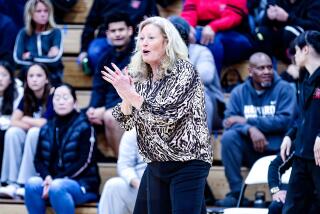Boys Meet Girls : Harvard and Westlake Merge in Coeducation With Barely a Ripple
The school’s nickname is new, the cafeteria features a daily salad bar to accommodate new appetites and students are on the lookout for any hint of gender-stereotyping in the classroom now that two of Los Angeles’ most prestigious private single-sex schools are one.
But there have been few of the wrenching changes and painful adjustments that opponents predicted when the merger of the Westlake School for Girls in Holmby Hills and the Harvard School for boys in Studio City was announced in 1989.
Two years of preparation by students, teachers, parents and administrators at the two academic and social powerhouses appeared to pay off last week in what almost everyone agreed was a remarkably smooth transition to coeducation. Moreover, administrators and teachers say the new 1,500-student Harvard-Westlake School became stronger than the sum of its parts without sacrificing the most important principles of either school.
“The gross distortions that people might have feared simply haven’t” happened, said Harvard-Westlake Headmaster Thomas C. Hudnut.
True, casual shorts and T-shirts had replaced the uniforms once worn at Westlake, which is now the campus for grades seven through nine, and the football team was hitting blocking sleds on a field used previously by the girls’ soccer team. At Harvard, which is now the high school campus, girls were encouraging boys to sign up as yell leaders and an interim student government in which a boy and a girl shared each elected position was shaping policy.
Even so, things seemed strikingly normal on the two shaded hillside campuses, as teachers quickly plunged into the rigorous curricula designed to springboard students toward success at elite colleges.
The start of classes was “unbelievably simple and well-functioning,” said Mike Metzger, a veteran math teacher at Harvard.
Teachers and administrators said they worked long hours to merge the two schools’ curricula, deciding to keep the advanced placement physics and chemistry classes from the Harvard schedule and to add advanced biology, photography, architecture and women’s studies from Westlake’s.
Consultants were hired to assist teachers with such things as avoiding classroom gender bias, a concern of some merger opponents who believed that girls are generally shortchanged in coeducational environments.
The process “jarred us out of institutional lethargy,” Hudnut said.
Another change was the hiring at the Harvard campus of a female rabbi to be a school co-chaplain. Harvard had long had ties to the Episcopal Church, which continue, while Westlake, which had a large number of Jewish students, was nonsectarian.
About 35% of the high school’s 800 or so students are Jewish, said Rabbi Jacqueline Ellenson. She said her hiring represents “a very definite statement to Jewish people that you belong here.”
Other efforts to make Jewish students comfortable include making Rosh Hashanah and Yom Kippur school holidays.
Other decisions had to be made about the merged institution’s colors (keeping Harvard’s red and black); nickname (the Wolverines, replacing Harvard’s Saracens and Westlake’s Wildcats); and dress code (no sweat suits outside the gym or athletic fields.)
Physical changes were required as well. Dance and photography studios and an additional chemistry lab were built on the Harvard campus and new restrooms and locker rooms put in at both. The cost of the merger was estimated at $2 million.
When the 1989 merger decision was announced, school officials said it would strengthen both institutions. Harvard, a former military school that had enrolled scions of rich and powerful actors and movie studio executives since 1900, was already planning to admit girls. But the cost of that move was estimated at $30 million, mostly for new buildings.
Had Harvard become coeducational but stayed independent, the leaders of Westlake--a former boarding school whose graduates during an illustrious 87-year history included astronaut Sally Ride and actress Candice Bergen--feared it would attract top qualified female students and accelerate an anticipated enrollment decline at Westlake.
Still, many Westlake parents were shocked by the decision. They said the merger was ill-conceived and that the school’s non-sectarian traditions were incompatible with Harvard’s affiliation with the Episcopal Church. But a Los Angeles Superior Court judge refused to grant the parents an injunction in December, 1989, and the lawsuit, which cost the schools $600,000 to fight, was later dropped.
Despite vows of mass defection, school officials said attrition at both schools in 1990 was about the same as in previous years. School officials said they knew of only five students who left Westlake to attend single-gender schools this year.
Harvard-Westlake admissions officials said the school’s popularity has risen. A record 1,200 students applied last spring for 220 spots in the seventh-grade class. Already, 375 prospective seventh-graders have applied to the school, which charges $9,850 for tuition, for next fall. The $1.25 million donated to the institution the first year after the merger was announced was more than the schools had raised when they were independent, officials said.
Studio City attorney Richard Close, whose daughter attended Westlake and is now a junior on the former Harvard campus, had spoken out against the merger when it was announced. He said he was impressed by how the transition has been carried out. “Even though I opposed what they did, they did it in an A-plus fashion,” he said.
However, although some boys and girls seemed to mingle easily last week, others were not so comfortable. “If you didn’t know the girls before, you’d be stranded, real stranded,” said Teague McKnight, a Hancock Park junior.
Several female students praised their teachers for going out of their way to make them feel comfortable. “All the teachers . . . are making a big point of saying they’re going to call equally on boys and girls,” said Johanna Cohen, a junior from Beverly Hills.
But it may take a while for other teachers to adjust. A class in which 15 girls and three boys were enrolled prompted the male teacher to remark, “What is this? A dance class?” a student in the class asked. The teacher apologized after a female student objected.
In another class, a history teacher on the former Harvard campus said the advent of coeducation meant he would have to discuss more social history because girls are less interested than boys in military history. Again, a female student complained about the teacher’s apparent stereotyping of girls and the teacher apologized.
Math teacher Wendy Van Norman said she will make sure her female students are full participants in the newly coeducational classrooms. “I think some of the girls might have less confidence and it’s our job to see that they walk out with more confidence,” she said.
Shelby Uritz, co-president of the senior class, said she continued to mourn the demise of Westlake as a separate institution.
“Westlake was a really great thing and I’m sorry we lost it, but Harvard-Westlake is a really great thing, too. Now, it’s like, it’s happening, so let’s make it work.”
More to Read
Sign up for Essential California
The most important California stories and recommendations in your inbox every morning.
You may occasionally receive promotional content from the Los Angeles Times.









